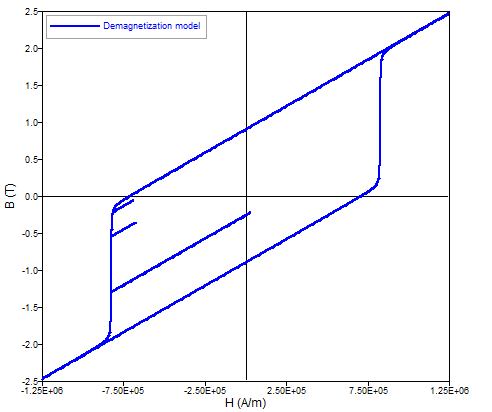B(H) law: Nonlinear analytical hard magnetic material
Presentation
This model (Nonlinear magnet described by HcB, HcJ and Br) defines a nonlinear B(H) dependence. Non-linearity is considered in the direction of magnetization whereas the model's behavior is linear in the transversal directions.
This magnet model is noted as unidirectional because the mathematical model and the direction of magnetization are dissociated. The mathematical model defines the demagnetization curve, while the direction of magnetization is defined by the orientation in the region.
Furthermore, this model can consider demagnetization during solving, wherever the curve knee is, if the corresponding option is selected (Demagnetization during solving).
Mathematical model
The mathematical formula used in Flux for the demagnetization curve is:
This formula is better clarified if we split it into the basic parts.
and
where:
- μ0 is the permeability of vacuum, μ0 = 4 π 10-7 H/m
- Br is the remanent flux density (T)
- HcJ is the intrinsic coercivity (A/m)
- Js is the saturation magnetic polarization (T)
Js is automatically computed by Flux when the magnetic field intensity H in the above mathematical formula B(H) is replaced by the normal coercivity -HcB value.
The shape of the B(H) and the J(H) dependence in the direction of magnetization are given in the figure below:
In transversal directions one can write:
where μr ┴ is the transversal relative permeability.
Direction of magnetization
The direction of permanent magnet magnetization is “dissociated” from the model. In the software, it is defined separately.
The various possibilities available to the user are shown in the table below. (The basic plane is a plane XOY.)
|
|
|
|
|
|
| Unidirectional |
Radial positive |
Radial negative |
Orthoradial positive | Orthoradial negative |
Demagnetization during solving
With this non-linear model, it is also possible to consider the demagnetization during solving (i.e. the irreversible degradation of a magnet's remanent magnetic flux density due to its interaction with a demagnetizing field) by checking the specific option that is provided during the Magnet LBC creation. This demagnetization model is based on a static Preisach approach and may apply in all quadrants of the magnet B(H) characteristic. The following additional remarks apply:
- Available for 2D and 3D in transient magnetic application
- In database containing a magnet LBC with Demagnetisation option active, it is advisable to set the application to perform an initialization through a static calculation ()
- This model does not take in account temperature variations

Dialog Box

- Open a Create Material dialog box in menu
- Choose Solid as Category field
- Choose Metal as Class field
- In Magnetic Properties:
- Choose Hard Magnetic type
- Choose Nonlinear BH model
- Define Remanent flux density Br
- Define Normal coercivity HcB
- Define Intrinsic coercivity HcJ
- Define Transversal relative permeability
μr
2 possibilities:
- Automatically computed through Br and HcB: μr =
Br/(μ0*HcB)
→ Transversal μr value is automatically computed an display in the Transversal μr value field below

-
User-defined

→ the user must enter a value in the Transversal μr value field
- Automatically computed through Br and HcB: μr =
Br/(μ0*HcB)